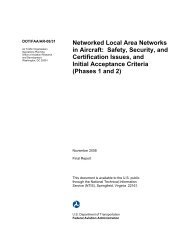Spark Ignition Aircraft Engine Endurance Test of Aviation ... - FAA
Spark Ignition Aircraft Engine Endurance Test of Aviation ... - FAA
Spark Ignition Aircraft Engine Endurance Test of Aviation ... - FAA
You also want an ePaper? Increase the reach of your titles
YUMPU automatically turns print PDFs into web optimized ePapers that Google loves.
Table 8 provides a summary <strong>of</strong> the exhaust gas data that was presented in figures 11 through 14.<br />
The EGT at the best power mixture, shown in column 4 <strong>of</strong> table 8, was higher by an average <strong>of</strong><br />
20° F for the AGE-85 than ISO, even with the 56.5% increase in fuel mass flow. This difference<br />
was more pronounced at the higher engine rpm settings <strong>of</strong> 2600 and 2700 and MAP settings<br />
above 26-in. Hg, where the AGE-85 average EHT was 32°F higher at best power than it was on<br />
ISO. At the lower rpm settings <strong>of</strong> 2400 and 2200, the best power average EGT was lower when<br />
operating on AGE-85 than ISO. Some <strong>of</strong> this elevated EGT for AGE-85 is due to operation at 5°<br />
retarded ignition timing and is due to varying the cooling air pressure to maintain fixed CHTs.<br />
The last two columns <strong>of</strong> table 8 show that the peak power on ISO occurred on average 136ºF rich<br />
<strong>of</strong> the maximum EGT, and for AGE-85, peak power occurred on average 110ºF rich <strong>of</strong> the<br />
maximum EGT. This data suggests that the maximum power occurred at leaner mixtures<br />
relative to stoichiometry for AGE-85 than ISO.<br />
Power Setting<br />
Table 8. Exhaust Gas Summary<br />
Max<br />
Corrected<br />
Power<br />
(Bhp)<br />
Fuel Flow<br />
at Max<br />
Corrected<br />
Power<br />
(lb/hr)<br />
Corrected<br />
BSFC at Max<br />
Corrected<br />
Power<br />
(lb/Bhp hr)<br />
Average<br />
EGT at Max<br />
Corrected<br />
Power<br />
(ºF)<br />
Max<br />
EGT<br />
(ºF)<br />
Difference:<br />
Max EGT<br />
Minus EGT at<br />
Max Corrected<br />
Power<br />
(ºF)<br />
ISO TO 191.1 90.1 0.475 1467 1602 136<br />
ISO 28-in. Hg, 2600 rpm 173.9 79.6 0.461 1462 1594 132<br />
ISO 26-in. Hg, 2600 rpm 157.8 73.7 0.468 1456 1596 140<br />
ISO 24-in. Hg, 2400 rpm 130.2 61.4 0.474 1435 1576 142<br />
ISO 22-in. Hg, 2200 rpm 101.2 48.9 0.483 1422 1553 132<br />
AGE-85 TO 197.0 137.8 0.700 1507 1608 101<br />
AGE-85 28-in. Hg, 2600 rpm 178.6 124.9 0.700 1486 1589 103<br />
AGE-85 26-in. Hg, 2600 rpm 162.0 115.3 0.714 1477 1589 112<br />
AGE-85 24-in. Hg, 2400 rpm 134.3 97.2 0.728 1448 1558 110<br />
AGE-85 22-in. Hg, 2200 rpm 103.7 77.3 0.754 1424 1549 125<br />
Figures 19 through 22 show the power performance and average EGT for both ISO and AGE-85<br />
versus air-to-fuel-ratio for TO, 28-in. Hg and 2600 rpm, 26-in. Hg and 2600 rpm, and 24-in. Hg<br />
and 2400 rpm, respectively. These figures illustrate further that the AGE-85 required much<br />
richer mixtures than ISO.<br />
20

















